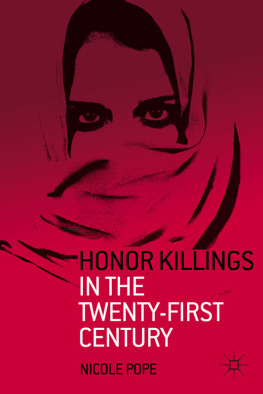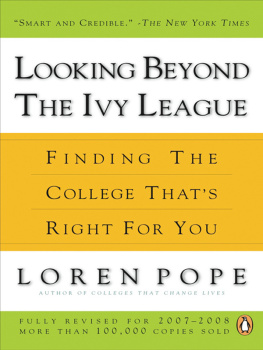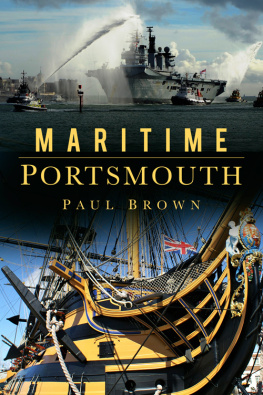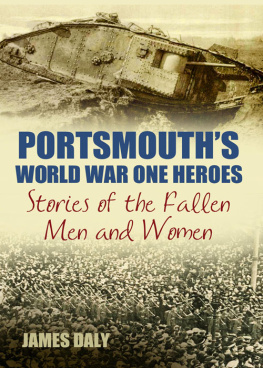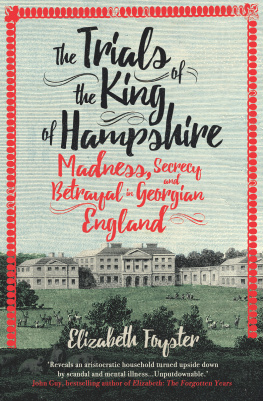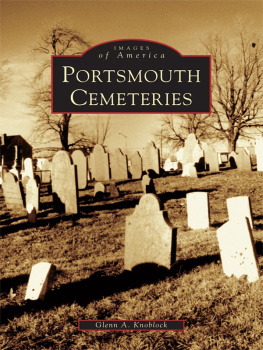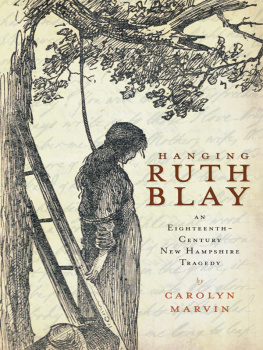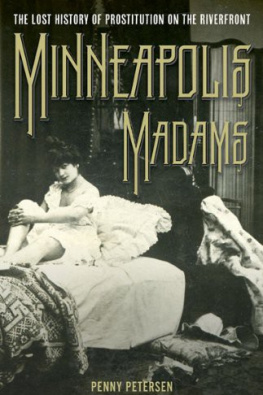
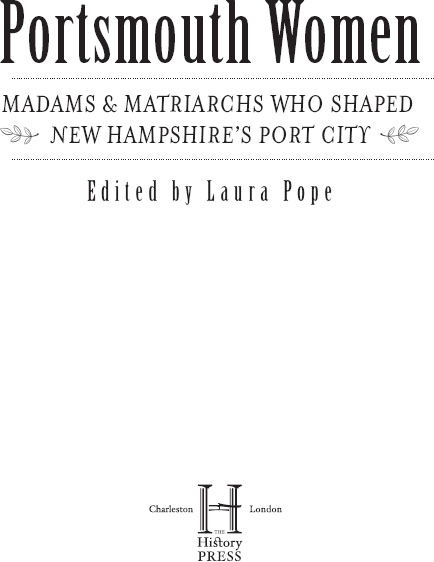
Published by The History Press
Charleston, SC 29403
www.historypress.net
Copyright 2013 by Laura Pope
All rights reserved
Front cover, clockwise from top left: Mayor Mary Carey Dondero emerges from a submarine at the Portsmouth Naval Shipyard. Courtesy Mary Carey Foley; The Just We Four Club from the Italian North End featuring (back row) Connie Canino, Connie Cochario, (front row) Ann Fiandaca and Edie DeStefano. Courtesy Pamela Fiandaca Given; Bordello madam Alta Roberts. Courtesy Kimberly Crisp; The Warner House, watercolor by Sarah Haven Foster. Portsmouth Public Library, Portsmouth, NH.
First published 2013
e-book edition 2013
Manufactured in the United States
ISBN 978.1.62584.553.5
Library of Congress CIP data applied for.
print edition ISBN 978.1.62619.100.6
Notice: The information in this book is true and complete to the best of our knowledge. It is offered without guarantee on the part of the author or The History Press. The author and The History Press disclaim all liability in connection with the use of this book.
All rights reserved. No part of this book may be reproduced or transmitted in any form whatsoever without prior written permission from the publisher except in the case of brief quotations embodied in critical articles and reviews.
To the intrepid Ella Wilson Morrison.
To the memories of Elizabeth P. Nowers and Jane D. Kaufmann,
who contributed their expertise to this book.
And to all Portsmouth women, ordinary and extraordinary,
who came before us.
Contents
Acknowledgements
Heartfelt thanks to my foremost supporter, John P. Schnitzler, for his unwavering encouragement and sage advice; to Jan McCracken for her timely suggestion to try another round of publisher inquiries; and to loyal friend and artist Jane Kaufmann, whose imagination and spirit make all creative endeavors adventurous.
My thanks and gratitude to all the contributing writers, whose curiosity, participation and patience made this book possible. Their willingness to push forward, to introduce new histories about Portsmouth women and to wait several years before a publisher came forward is a testament to the storyteller gene within all of us. Its been a privilege working with them.
My appreciation goes to the many who helped me gather photos for this book: Nicole L. Cloutier at Special Collections, Portsmouth Public Library; historians J. Dennis Robinson and Maryellen Burke; Tom Hardiman, Keeper at the Portsmouth Athenaeum; Elizabeth Farish at Strawbery Banke museum; Nancy M. Carmer, Richard Hopley and John Bohenko at Portsmouth City Hall; Susan and Chip Kaufmann; Joseph Fiandaca and Pamela Fiandaca Given; Kimberly Crisp; Dr. Richard Candee and Robert S. Chase; Deborah M. Child; James Garvin; and the New Hampshire State Archives.
Lastly, my sincere thanks to the gimlet-eyed Brenda Gaudet, who ensures all writers words read well.
Introduction
The curiosity that presages actionin this case, the seed that spurred putting together this anthology of womens historybegan in the mid-1980s, following my time as an archaeologist at Strawbery Banke, a ten-acre maritime museum in the lively river town of Portsmouth, New Hampshire. Like other staff, I found myself immersed in the histories of founding families, sea captains, merchants and craftsmen, but I could not stop wondering about the sisters, wives and mothers of these prominent citizens.
After gathering a list of subject women, whose quite varied lives spanned three centuries, I then paired each with a female biographer from the ranks of journalists, historians and scholars. The eight biographies in Portsmouth Women represent, for the most part, new histories of women well outside the mainstream.
Employing a full arsenal of research methodsfrom oral histories, letters and public records to genealogies, new scholarship and discovery of new materialsthe biographers of Portsmouth Women unearthed a satisfying, if small, sample of female history in the city.
A major thoroughfare in the city summons the memory of a twice-widowed philanthropist, Bridget Cutt Daniel Graffort, who devoted her real estate to education. During her life in the seventeenth-century, fledgling city, she witnessed several skirmishes and more than one war between colonists and native peoples and rose to wealth as the widow of distinguished men.
In her biography, we get a glimpse of upper-class life, orderly Puritan hierarchy and how a fathers love of education passed to his daughter and, ultimately, to Portsmouth. We get a snapshot of a prominent woman during a time when womens roles might have been appreciated but never saved for future generations to explore.
Another widow, Allice Frost Shannon Hight is barely remembered as a tavern keeper before the American Revolution, though a few remaining tax records reveal a tenacious woman who outlived two husbands and raised ten children, all while helping to run a prosperous tavern and ferry service. She is the quintessential model of super motherhood. Elizabeth Nowers recounts Hights story here. Based on information culled from surviving wills, court documents, newspaper advertisements and tax records, it is a sobering glimpse of eighteenth-century business practices involving real estate and legal issues.
Female artists left their mark as well.
Sarah Haven Foster dedicated her words and art to preserving a nostalgic view of Portsmouth in her Guidebook and, thus, added tremendously to the citys future tourism industry. Maryellen Burke authors a detailed peek into this talented artists life.
Quite famous in her day, Portsmouth painter Susan Ricker Knox virtually evaporated from the historic record after her death. Historian Jane D. Kaufmann revives Knoxs considerable contributions to the art world here as well as her influence over immigration legislation.
Ellen and Brownie Gerrishthe wife and daughter of sea captain Edwin Gerrishwent to sea to face unimaginable perils and were only recorded in the historic record because of their involvement in a famous Civil War sea battle. Here, their lives on ships speak to the issue of womens roles at sea, a topic that has gained considerable academic attention in the last few years. Sailor, scholar and writer Kate Ford Laird breathes life into an existence at sea that a small number of women experienced at this time.
Mary Baker and Alta Roberts were enterprising women whose stories are often deliberately obliterated through a lack of further investigation or an unwillingness to discuss the subject of Portsmouths once flourishing prostitution trade along the waterfront, especially since this same district now encompasses the citys finest park and the largest arts festival in the region. Kimberly Crisp, grandniece of Roberts herself, tells their stories, as well as their distinct brand of commerce, here.
Among these pioneering spirits and ordinary women may be found a couple of real charmers, including a Sicilian immigrant named Rose Rizza Fiandaca, who reigned as the unofficial matriarch and midwife of a bustling Little Italy, and a poor girl named Mary Carey Dondero from the South End, who later became the first female mayor in Portsmouth and a beloved political figure for whom a Portsmouth elementary school is named.
Though this book is just a first step in the direction of relating compelling stories about Portsmouth women, it will perhaps instigate more scholarly research into the surprisingly varied and interesting lives of women in Portsmouth and other communities already rife with the histories of male accomplishment. In additional pursuits of female history, more information about notable women from witness accounts, oral histories, diaries, museum catalogues and newspaper clippings may be identified and organized, ultimately finding its rightful place in our collective history.
Next page


